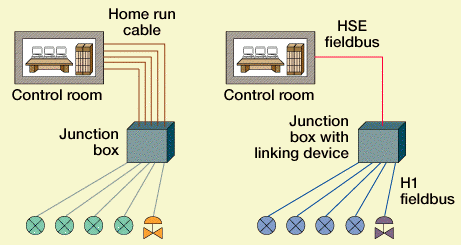Fieldbus introduces new concepts in process control
Fieldbus introduces new concepts in process controlDevicebuses and sensorbuses complete the architectureR. H. Caro, ARC Advisory Group, Dedham, Massachusetts
Fieldbus. It has been a long wait for a process control digital fieldbus, but commercial products are now being delivered to early adopters of this technology. One primary cause of the delay is the complexity of standards necessary to achieve interoperability between suppliers in this market. These standards have taken far too much time to create, as vendors have attempted to influence the standardization process to achieve their own competitive advantage or simply to delay the process allowing additional time for marketing existing products. This is now behind us as field instrumentation products are being produced to two different, but strongly-related standards: FF and PPA. FF conforms to ANSI/ISA S50.02 (an American National Standard) and PPA conforms to EN 50170-2 ("EuroNorm," a standard for the European Economic Community.) The international standard, IEC 61158 is the same as the ISA standard, but differences from the European standard have delayed its acceptance. The important fact is that both standards are being supported by many manufacturers of process control field instrumentation and control systems. A primary benefit of fieldbuses has been reduced installation cost enabled by the digital addressability of the instruments. Traditional installation of process control analog instruments, including HART, have required validating the dedicated wire pair between each instrument in the field and its final termination in the control room. With fieldbus instruments, the tag name is not assigned to the termination rack wire-pair but is present in the instrument itself. Therefore, it is not necessary to validate all intermediate connections since the instrument only needs to connect to the network, and respond to a query of its tag name — part of the fieldbus protocol. Savings accrue from reduced labor costs needed to validate (also called "ring-out") each instrument connection. Additional savings also are possible when digital field instruments are terminated in field-mounted network elements that concentrate the data onto higher speed networks — such as PROFIBUS-DP or Foundation fieldbus HSE. High-speed networks reduce the number of wires required, and installation cost, to enter the control center.
Another major benefit of the digital fieldbus in process control applications is field control — the ability to perform time-synchronous process control computations in field devices. Since FF is based on the ISA standard, which provides protocol support for field control, users of conforming devices will be able to use this feature if their equipment supports it. PPA does not directly support field control but is oriented to more traditional control in a network master controller. The Fieldbus Foundation holds the Fisher-Rosemount patent on field control and will license it only if the application is based on FF. At present, field control is not an important factor in the market, since most systems still perform control calculations in a multifunction controller. However, most process control valve positioner vendors supply FF support with function blocks for PID loop control. PPA is defined with a set of "profiles" for many different field device types, but control is not among the completed set since it is intended to be in the master controller. Eventually, field control will tend to drive these two different standards together. In addition to field control, both of these fieldbus standards allow for strong bidirectional communications with intelligence in the field instrument. Since 1991, HART has been available to communicate with smart field instruments superimposed on the 4-20 mA analog signal but only at 1,200 bps data rate. Likewise, Profibus-FMS has also been available to communicate with smart instruments at 9,600 bps but without analog transmission. FF and PPA allow digital communications at 31,250 bps, with optional intrinsic safety barriers, and deliver electrical power to field instruments. The higher speed of these two protocols allows the digital signal to be used for fast process control. Users are confused by the existence of two standards for process control instrumentation, especially since the single 4-20 mA standard has been used worldwide for analog signal transmission in process control since the mid-1960s. Both FF and PPA use the same standard for electrical connections (Physical Layer), IEC 61158-2, but differ in the protocol (Data Link Layer) such that they cannot interoperate on the same network. This unfortunate situation exists since Profibus protocol has been offered in products since 1993, and its proponents do not wish to modify existing products. While the standards committee generating the IEC 61158 protocols has included all Profibus logic, it has been unwilling to include the detailed encoding used by Profibus. Compromise is possible if both parties are willing. Devicebus. The fieldbus concept has also been applied to connecting simpler instrumentation used in automotive, discrete parts manufacturing and batch process control. At ARC, we call this type of network a devicebus. This concept was first introduced for factory automation applications with Profibus-FMS in 1991. However, it did not become widely used until the introduction of Profibus-DP in 1995. The stated purpose for most devicebuses is to connect sensors and actuators to a common bus for bidirectional communications. However, sensors such as limit switches, proximity detectors, bar code readers, photo detectors, actuators such as solenoid air valves and variable speed electric motor drives, are not being directly connected to digital networks. In most cases, these devices are being wired to remote multiplexing devices that convert the sensor and actuator data to bits in a binary register. The multiplexer device is located in the field to reduce wiring cost and is connected to a programmable logic controller (PLC) with a digital network. Networks used for this connection include DeviceNet, SDS, ControlNet, Profibus-DP, WorldFIP, Interbus and Ethernet. Of these, Profibus and WorldFIP are parts 2 and 3 respectively of EN50170. Ethernet conforms to standard ISO 8802.3. The others are "open specifications" in the hands of independent nonprofit consortiums. A few sensors and actuators are beginning to appear for direct connection to devicebuses such as DeviceNet and SDS, both based on the controller area network (CAN) originally developed for use inside the automobile. Even though the same CAN chip is used by DeviceNet and SDS, different electrical characteristics have been used for the physical wiring preventing interoperation. It does not appear that the opposing groups will ever resolve these differences, and they will continue. This is not as big a problem as it would seem, since interfaces for each of the two physical layers are available for many commercial multiplexing devices. Also, direct connection of factory floor sensors and actuators with devicebus has not been as popular as once conceived. The primary benefit of devicebus is distributing intelligence to the sensor, actuator or multiplexer device. At present, intelligence is concentrated in the host PLC, but some intelligence is beginning to appear in multiplexing devices. When intelligence can be economically distributed to sensors and actuators, benefits will become available from improved diagnostics, decreased load on the host PLC, decreased network loading and improved control. Each discrete sensor type can determine its own condition from local data such as contact resistance, lamp status, or average proximity reading. In many cases, it can alarm on drift or pending failure. While such detection can be built into PLC logic with additional sensors, it is rare. Control with the best quality data has always been proven to yield benefits. Building them into the sensor lowers cost and assures that these technology improvements will actually be used. When intelligence is distributed to the smart discrete sensor and actuator, much of the routine PLC logic can be removed. For example, filtering contact bounce in a limit switch with an analog RC filter increases response time, so it is often done digitally in the PLC requiring complex logic that is often repeated for every limit switch. This logic can be done in the limit switch itself by the switch designer. Similarly, detecting lamp failure for a photocell should not waste PLC resources but can be alarmed by the sensor itself. Actuators such as solenoid valves are usually the element controlled by interlock logic using data from sensors that can easily be arranged to be on the same devicebus segment. If the interlock logic is moved to the actuator, the load on both network and PLC is greatly reduced. Variable-speed electric motor drives are very complex devices that can offer a great deal of applications functionality and performance information to control systems. For example, much of the control functionality for elevators — including speed ramping, floor approach control and braking — can be assigned to the drive where all load and speed information are local variables. So far, very few factory automation sensors or actuators are being implemented directly on devicebuses or have any applications intelligence. Vendors of PLCs are also among the principal suppliers of sensors and actuators and do not wish to see their market eroded by logic in sensors and actuators. But, there are many smaller suppliers that view adding intelligence to sensors and actuators as a competitive advantage. It seems that this area will also be strongly affected by moving intelligence to the lowest network levels but not as rapidly as process control. Sensorbus. To further save on the wiring cost, two network protocols have been defined in which an interface chip is placed in the field sensor or actuator allowing the device to be directly addressed across a simple network which we call a sensorbus. ASi-Bus is the only standard sensorbus and is defined as part of EN50245. Seriplex is another sensorbus defined by an open protocol and is very similar to ASi-Bus. These are called "slotted ring" protocols and allow information from each device to be transmitted at a specific time slot. The master device then identifies each device by the time slot. Transmission is in only one direction, from the device to the master for sensors, and from the master to the device for actuators. The only benefit of either protocol is to save on the installation cost by allowing point-to-point wiring. This is offset by the higher cost of the device. The long-range prospects of sensorbuses are not as strong as for devicebuses. The devicebus market is much larger, and the relative costs of the interfaces are converging. Only a few dedicated suppliers produce sensors and actuators with sensorbus interfaces, and the number is not increasing. Sensorbus will not disappear in the next five years, but it will not exhibit the growth of devicebus or fieldbus. FB The author
Copyright © 1999 World
Oil |


 Richard
H. Caro is vice president of ARC Advisory Group. He
is the chairman of both the ISA SP50 and International Electrotechnical Committee Fieldbus
Standards Committees. Before joining ARC, Dick held the position of senior manager with
Arthur D. Little, Inc., Inc. in Cambridge, Massachusetts. He was a founder of Autech Data
Systems, and was director of marketing at ModComp. In the 1970s, The Foxboro Company
employed Dick in both development and marketing positions. He holds BS and MS degrees in
chemical engineering, and an MBA.
Richard
H. Caro is vice president of ARC Advisory Group. He
is the chairman of both the ISA SP50 and International Electrotechnical Committee Fieldbus
Standards Committees. Before joining ARC, Dick held the position of senior manager with
Arthur D. Little, Inc., Inc. in Cambridge, Massachusetts. He was a founder of Autech Data
Systems, and was director of marketing at ModComp. In the 1970s, The Foxboro Company
employed Dick in both development and marketing positions. He holds BS and MS degrees in
chemical engineering, and an MBA.
